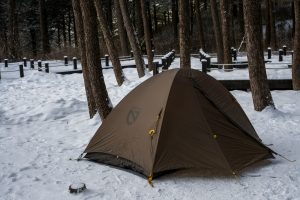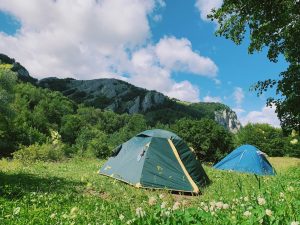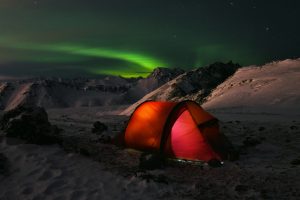Choosing the right Tent Material for Winter Camping is one of the most important decisions you’ll make before heading into the wild — especially when you’re preparing for colder conditions. Tent fabrics impact everything from weight and durability to weather resistance and warmth. Whether you’re car camping in chilly weather or setting up a basecamp in the snow, the material and design of your tent play a major role in your safety and comfort.

In this guide, we’ll explore the best tent materials for both cold and warm weather camping, and what you should look for in a four-season setup.
Key Considerations When Choosing a Tent Material
❄️ Season Rating and Purpose
-
4-Season Tents: Built for winter, snow, and high winds — ideal for alpine or cold-weather camping. These tents are designed to stand up to harsh elements with stronger frames and more fabric coverage. Check out top-rated options on REI, or browse deals on Amazon, Walmart, and Temu to find one that suits your winter adventures.

-
3 or 3+ Season Tents: Usable year-round in milder winter conditions if properly designed — look for sturdy construction and waterproofing. Usable year-round in milder winter conditions if properly designed — look for sturdy construction and waterproofing. You can explore reliable models at REI, or compare affordable picks on Amazon, Walmart, and Temu.

Think about where and when you’ll be camping. Are you backpacking in the summer or setting up a tent in late autumn? Your activity and climate determine which material is best.
🪶 Weight vs. Durability
-
Backpacking? Opt for nylon or polyester tents. They’re lightweight, compact, and quick to dry.Check out trusted backpacking tents at REI, or browse budget-friendly options on Amazon, Walmart, and Temu.

-
Basecamp or long-term stays? Consider canvas for its unbeatable durability and insulation — though it’s heavier and bulkier. Browse high-quality options like canvas wall tents on Amazon, bell tents on Walmart or premium outfitter tents at White Duck Outdoors.

🌧️ Weather Resistance and Insulation
-
Canvas provides excellent thermal insulation, keeping heat in and cold out. It’s great for cold weather and year-round use but needs more care and setup time. Canvas provides excellent thermal insulation, keeping heat in and cold out. It’s great for cold weather and year-round use, though it requires more care and longer setup. Explore durable, weather-ready options like heavy-duty canvas tents on Amazon, insulated canvas tents on Walmart, or 4-season canvas tents on White Duck Outdoors.
-
Nylon and polyester are naturally water-resistant and quick drying, ideal for rain or snow when treated properly. Look for a flysheet with at least PU3000mm and a tent floor rated PU5000mm or higher. Nylon and polyester are naturally water-resistant and quick drying, ideal for rain or snow when treated properly. For reliable weather protection, look for a flysheet rated at least PU3000mm and a tent floor rated PU5000mm or higher — options like the PU3000mm waterproof tents on Amazon, high-rated polyester tents on Walmart, or lightweight waterproof tents on REI meet these criteria.
Tents with fabric-lined inner walls retain more warmth and shield you from wind chill.
💨 Wind and Snow Load Handling
-
Choose tents with geodesic or dome-shaped structures for better wind resistance and snow shedding. These designs distribute pressure evenly and are more stable than tunnel or cabin shapes. Choose tents with geodesic or dome-shaped structures for better wind resistance and snow shedding. These designs distribute pressure evenly and are more stable than tunnel or cabin shapes. You can find great options like the dome-shaped winter tents on Amazon, geodesic camping tents on Walmart, or 4-season geodesic tents on REI.

🌬️ Ventilation
-
Good airflow prevents condensation — a major issue in cold weather camping. Look for:
-
Adjustable vents
-
Mesh panels with zip covers
-
Dual-layer doors
-
Balancing ventilation with insulation is key — especially in still, cold conditions where breath moisture builds up.
🛠️ Tent Fabric Types – Pros & Cons
| Material | Best For | Pros | Cons |
|---|---|---|---|
| Nylon | Backpacking, 3-season use | Lightweight, durable, water-resistant, quick-drying | UV degradation over time |
| Polyester | General use, rainy climates | Affordable, durable, good UV resistance, quick-drying | Slightly less breathable than nylon |
| Canvas (Cotton) | Basecamping, cold weather | Excellent insulation, long lifespan, breathable | Heavy, bulky, requires maintenance |
🧼 Ease of Maintenance
-
Canvas needs occasional treatment with waterproofing and UV protection sprays but can last decades.
-
Nylon and polyester need less upkeep and are easier to pack down wet (but should still be dried out fully to avoid mildew).
💰 Budget and Value
-
Canvas tents are more expensive upfront but last longer and provide better comfort in extreme conditions.
-
Polyester and nylon options are more budget-friendly and practical for casual campers or backpackers.
➕ Extra Features to Look For in a Winter-Ready Tent
-
Vestibules: Storage areas for gear and protected cooking zones. Here is an article about it.
-
Guy lines & sturdy pegs: Secure your tent against strong winds and snow.
-
Groundsheet or footprint: Adds insulation and protects your tent floor from moisture.
-
Tarp or fly: Offers extra coverage and a flexible shelter option for cooking or relaxing.
What’s the Best Tent Material for Hot Weather?
-
Nylon is a top choice for warm climates thanks to its breathability and lightweight nature.
-
Polyester works too but is typically less breathable unless paired with ample ventilation.
-
Look for tents with large mesh windows, light-colored fabric (to reflect sunlight), and elevated rainflies for better airflow.
And for Cold Weather?
-
Go with canvas if you’re planning long stays in frigid conditions or setting up a heated hot tent — it insulates well and resists wind.
-
Use polyester if you want a lighter cold-weather tent that still offers good waterproofing and decent insulation.
-
Focus on tent shape, ventilation, and rainfly coverage for managing internal warmth and condensation.
Final Thoughts

Choosing the right tent fabric depends on your camping style, climate, and comfort expectations. For serious winter adventures, invest in a 4-season canvas or reinforced polyester tent. For hot-weather hikes, stick to lightweight nylon with strong ventilation features.
Wherever you pitch your tent, make sure it’s tailored to your trip — and your tent fabric is up for the challenge. Want a broader look at tent fabrics beyond cold-weather use? Read our Ultimate Guide to Choosing the Right Tent Material for a detailed breakdown of canvas, nylon, and polyester in every season.
Leave a Reply